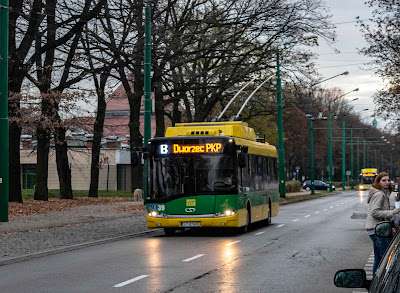Look at this! An iconic image of the Stalinist era. Should it be painted over, or left for posterity? Where have I seen this before - on Pl. Konstytucji in Warsaw? Or on the cover of the 1949 Worker's Diary?
Below: Socialist Realism was neo-classical in form; street layouts inspired by Ancient Rome
Unofficial street art. Would Stalin and his henchmen have sought to track down and punish the author(s) of this criticism of the aesthetic conditions of this workers' paradise? What agent of Imperialist England (note the spelling: not 'color' as a CIA saboteur would have written) stands behind this attempt to subvert the Polish People's Republic? This photo is unaltered in Photoshop.

Left: literal translation - 'Prohibition of Game with Ball'.
Below: Tychy New Town (Nowe Miasto) is close to Tychy's main railway station. Two passenger trains from the Silesian regional railway operator SKR pass one another, while a PKP Cargo Siemens Vectron engine runs light between the platforms.
Below: what's this? A fire station? A film set? Security towers at a sensitive border crossing?
Left. No. This is a Catholic church. The parish church of St Francis of Assisi and St Clare. It looks like a defensive bastion - a fortified emplacement, a science-fiction structure - if the former, who is it protecting the parishioners against? And if the latter - I'd bet that it is successful in attracting those with an interest in fantasy fiction. One way or another, it's a church reflecting these times. (See it on Google Maps Street View 3D - impressive!)
Below: Tychy is one of three Polish cities that currently still have a trolleybus network - the others being Lublin and Gdynia. While the trolleybuses constitute the minority of the Tychy bus fleet, the bulk of the non-electrified buses are powered by compressed natural gas.
For a heavily industrialised town, having electric powered buses cuts back a bit on air pollution. The bulk of the non-trolleybus fleet is powered by compressed natural gas. Which also helps.
Below: but what's this? Back at the Tychy station, watching the imminent arrival of the InterCity train from Białystok to Bielsko-Biała... just look at the smoke pouring out of the signal box! You'd think that PKP could easily heat such buildings from the electricity in its overhead power lines - but no - filthy coal is being burnt.
This time three years ago:
Face to face with the UK retailing scene
This time four years ago:
Bricktorian Birmingham
This time six years ago:
Welcome to Lemmingrad
This time eight years ago:
Dream highway
This time ten years ago:
The Days are Marching
This time 11 years ago:
First snow, 2007

















No comments:
Post a Comment